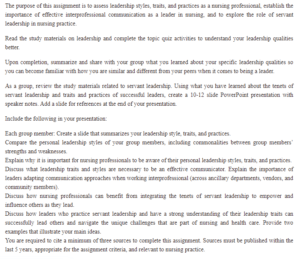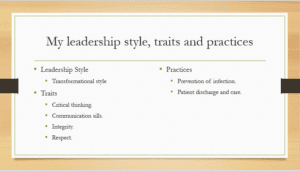Leadership In Nursing
This presentation focuses on assessing leadership styles, traits, and practices as a nursing professional, establishing the importance of effective interprofessional communication as a leader in nursing, and exploring the role of servant leadership in nursing practice.
Here’s an outline of my presentation. I’ll start by introducing the concept of leadership and nursing and the main roles of leaders in the healthcare sector. I’ll then provide an overview of my leadership style, traits, and practice. Next, I’ll review the commonalities in my group members’ strengths and weaknesses and also check the differences between my group members’ strengths and weaknesses. I’ll then check why nursing professionals need to be aware of their personal leadership styles, traits, and practices. Next, we’ll discuss the necessary leadership traits and techniques to be an effective communicator. I’ll then discuss the importance of leaders adapting communication approaches when working interprofessionally. Lastly, I’ll review how nursing professionals can benefit from integrating the tenets of servant leadership to empower and influence others as they lead and discuss how leaders who practice servant leadership and have a strong understanding of their leadership traits can successfully lead others and navigate the unique challenges that are part of nursing and healthcare.
According to Al-Dossary(2017), leadership in nursing is defined as the behaviors of staff nurses that provide direction to healthcare teams and support to clients in the delivery of healthcare.
Providing guidance and support includes guiding the healthcare teams on what they should do to create a positive patient outcome and ensure that clients are satisfied with the services they receive. They also have an active role in making decisions that determine the course of action in providing healthcare. Such decisions may include deciding whether to provide healthcare to a patient who has made a partial payment for healthcare services or not based on the fact that healthcare teams can not make such a decision on their own.
Leaders in nursing focus on both healthcare teams and clients because they need to guide the healthcare teams while listening to what the clients want to guarantee client satisfaction.
Leaders in nursing are also expected to coordinate activities in the healthcare facilities to ensure that the required equipment and personnel are provided.
My leadership style is the transformational leadership style, which focuses on motivating followers to own their roles and perform beyond their expectations.
One of my leadership traits is critical thinking. I often consider all aspects of an issue to find a solution and also be innovative to come up with new ideas that can be used to improve my work output and improve my life.
My second trait is communication skills. I use communication skills to communicate what I intend to say in the most effective way I can.
My third trait is integrity. I use this skill to make the right choices, particularly in situations where I encounter a conflict of interest.
My third trait is respect. I exhibit respect for those around me and work on creating a good relationship with them to avoid conflict.
One of my nursing practices is the prevention of infection by maintaining hand hygiene after every interaction with a patient and when exiting and entering a patient’s room.
My second practice is patient discharge and care by ensuring that patients are only discharged when they are in good health.
One of the strengths of transformational leadership is that it facilitates achieving goals by encouraging teamwork and collaboration because employees are encouraged to take ownership of the responsibilities assigned to them and perform beyond their expectations. It additionally motivates followers, thus increasing productivity. Transformational leadership also creates a good rapport because followers are allowed to work freely without feeling intimidated by their leaders (Alloubani & Akhu-Zaheya, 2018).
Democratic leadership increases a sense of belonging because leaders and followers work together to enhance the performance of the organization. It also increases transparency because leaders and followers collaborate in decision-making and share all the information they have. Engaging in decision-making enhances collaboration because both followers and leaders are actively involved in the decision-making process (Alloubani & Akhu-Zaheya, 2018).
Laissez-faire leadership enhances autonomy because teams are allowed to function as they like as long as they meet organizational goals and follow policies and procedures. Freedom creates a conducive working environment, hence increasing productivity (Alloubani & Akhu-Zaheya, 2018).
Autocratic leadership facilitates quick decision-making because leaders do not require the input of their followers (Alloubani & Akhu-Zaheya, 2018).
Servant leadership results in effectively leading diverse teams because it focuses on building relationships and developing the skills of team members (Alloubani & Akhu-Zaheya, 2018).
Transformational leadership requires implementing an existing structure so that further growth and development can occur (Alloubani & Akhu-Zaheya, 2018).
Democratic leadership, laissez-faire, and servant leadership are time-consuming because they involve collaboration among team members in decision-making (Alloubani & Akhu-Zaheya, 2018).
Autocratic leadership does not promote communication and trust among team members because leaders do not engage team members in the administration and decision-making process. The lack of collaboration among team members and leaders further limits transparency (Alloubani & Akhu-Zaheya, 2018).
Being aware of personal leadership styles, traits, and practices for nursing professionals helps in understanding strengths and weaknesses. Nurses can then use this information to strategically use their powers to improve patient care and eliminate the faults that affect their performance in the healthcare field.
Being aware of personal leadership styles, traits, and practices for nursing professionals also helps in identifying nursing practices that are well suited to the recognized leadership style, hence improving nursing practice by offering the best healthcare services(Melnyk & Neale, 2019). It also helps in identifying the nursing practices that are well suited to the leadership style. For instance, a person with transformational leadership practices may opt to work in patient care because it promotes collaboration between healthcare providers and patients.
Democratic and transformational leadership styles are necessary to be an effective communicator because they include working with many people who require constant communication.
Active listening is necessary to be an effective communicator because it includes understanding what is being said and responding appropriately.
Transparency is necessary to be an effective communicator because it encourages clearly providing all the required information.
Empathy is necessary to be an effective communicator because it enables individuals to read the emotions of the people they are communicating with, thus responding appropriately.
Integrity is necessary to be an effective communicator because it facilitates the provision of truthful information.
Adapting communication approaches when working interprofessionally helps in motivating and inspiring followers by electing an appropriate communication approach in different scenarios. It also helps in gaining leadership practices with organizational strategy and vision by effectively communicating with employees.
Adapting communication approaches also help in persuading followers to meet organizational goals by effectively communicating with them(Banwart, 2020). It also helps in selecting the system that effectively conveys critical ideas and thoughts because appropriate methods can be used based on the current scenario.
Adapting communication approaches when working interprofessionally also helps in maximizing leadership impact in the organization by communicating with employees effectively.
Integrating the tenets of servant leadership to empower and influence others as they lead helps in creating better psychological well-being of the nurses and their followers by reducing the emotional drain for the nurse and their followers. This mainly occurs because it makes favorable job attitudes. After all, the leader focuses on meeting the needs of followers. Meeting employee needs and good job attitudes contributes to enhancing productivity.
Integrating the tenets of servant leadership to empower and influence others as they lead also results in fewer conflicts because followers are not deviant.
Leaders who practice servant leadership and have a strong understanding of their leadership traits can successfully lead others and navigate the unique challenges that are part of nursing and healthcare by creating stronger teams and collaboration. For instance, if a patient has an individual psychological disorder, the leader can create a group of nurses who have specialized in psychological care so that they can come up with a solution and help each other deal with the challenges they may encounter when attending to the patient. This helps in creating a positive work environment because nurses are there for one another and collaborate to enhance patient care.
Leaders who practice servant leadership and have a strong understanding of their leadership traits can successfully lead others and navigate the unique challenges that are part of nursing care by increasing commitment, loyalty, and trust. For instance, the leader can set targets for a team of nurses, such as finding a remedy for a certain illness, hence motivating them to work together. Being involved in patient care by being assigned different tasks that include extensively applying nursing knowledge and capabilities also helps in creating a sense of belonging.
Leaders who practice servant leadership and have a strong understanding of their leadership traits can successfully lead others and navigate the unique challenges that are part of nursing and healthcare by providing training and development. For instance, during the current pandemic, a leader can organize training programs to equip nurses with knowledge on how to handle COVID-19 patients and how to deal with challenges arising from COVID-19 19, such as the pressure to maintain limited contact with the patient and attend to many patients per day due to congestion in hospitals.
Al-Dossary, R. N. (2017). Leadership in nursing. Contemporary Leadership Challenges. https://doi.org/10.5772/65308
Alloubani, A., & Akhu-Zaheya, L. (2018). Leadership styles and theories. Leadership Styles and Nursing Care Management, 1-23. https://doi.org/10.2174/9781681087450118010003
Banwart, M. (2020). Communication studies: Effective communication leads to effective leadership. New Directions for Student Leadership, 2020(165), 87-97. https://doi.org/10.1002/yd.20371
Melnyk, B. M., & Neale, S. (2019). Key strategies for optimizing personal health and well-being: A necessity for effective leadership. Evidence-Based Leadership, Innovation, and Entrepreneurship in Nursing and Healthcare. https://doi.org/10.1891/9780826196255.0004
ORDER A PLAGIARISM-FREE PAPER HERE
We’ll write everything from scratch
Question
The purpose of this assignment is to assess leadership styles, traits, and practices as a nursing professional, establish the importance of effective interprofessional communication as a leader in nursing, and explore the role of servant leadership in nursing practice.

Leadership In Nursing
Read the study materials on leadership and complete the topic quiz activities to understand your leadership qualities better.
Upon completion, summarize and share with your group what you learned about your specific leadership qualities so you can become familiar with how you are similar and different from your peers when it comes to being a leader.
As a group, review the study materials related to servant leadership. Using what you have learned about the tenets of servant leadership and traits and practices of successful leaders, create a 10-12 slide PowerPoint presentation with speaker notes. Add a slide for references at the end of your presentation.
Include the following in your presentation:
Each group member: Create a slide that summarizes your leadership style, traits, and practices.
Compare the personal leadership styles of your group members, including commonalities between group members’ strengths and weaknesses.
Explain why it is important for nursing professionals to be aware of their personal leadership styles, traits, and practices.
Discuss what leadership traits and styles are necessary to be an effective communicator. Explain the importance of leaders adapting communication approaches when working interprofessional (across ancillary departments, vendors, and community members).
Discuss how nursing professionals can benefit from integrating the tenets of servant leadership to empower and influence others as they lead.
Discuss how leaders who practice servant leadership and have a strong understanding of their leadership traits can successfully lead others and navigate the unique challenges that are part of nursing and health care. Provide two examples that illustrate your main ideas.
You are required to cite a minimum of three sources to complete this assignment. References must be published within the last five years, appropriate for the assignment criteria, and relevant to nursing practice.













